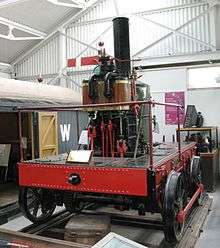South Devon Railway 0-4-0 locomotives
The South Devon Railway 0-4-0 locomotives were small 0-4-0 broad gauge locomotives operated on the South Devon Railway, Cornwall Railway, mainly on the dockside lines around Plymouth.
On 1 February 1876 the South Devon Railway was amalgamated with the Great Western Railway, the locomotives were given numbers by their new owners but continued to carry their names too.
Tiny
| Tiny |
|---|
| Type and origin |
|---|
| Power type |
Steam |
|---|
| Builder |
Sara and Company |
|---|
|
|
|
|
|
- Tiny (1868 – 1883) GWR no. 2180
Tiny was built by Sara and Company. It has a vertical boiler and was similar to four locomotives that later worked in the docks at Falmouth in Cornwall.[1]
After withdrawal it was used at Newton Abbot where it was used to power machinery in the workshops there. In 1927, no longer required for this purpose, it was displayed on the platform at the station opposite the workshops. It has since been moved to Buckfastleigh railway station where it is displayed in the museum of the South Devon Railway Trust.
Owl class
The three Owl class locomotives had well tanks and were built by the Avonside Engine Company.[2]
- Owl (1873 – 1889) GWR no. 2172
- The locomotive was named after the bird Owl.
- Goat (1873 – 1885) GWR no. 2174
- The locomotive was named after the animal Goat.
- Owl and Goat were withdrawn and stored. In 1890 they were sold to Pearson and Son, engineers contracted to work on the railway near Ivybridge.[2] Once this work was finished in 1893 they were sold back to the Great Western Railway, then converted to standard gauge and worked until 1913.
- Weasel (1873 – 1882) GWR no. 2173
- The locomotive was named after the animal Weasel. It was withdrawn in 1882 and scrapped.[2]
Raven class
The seven Raven class were saddle tank locomotives and were again built by the Avonside Engine Company. They were highly unusual for broad gauge locomotives in having outside cylinders.[3]
- Crow (1874 – 1892) GWR no. 2177
- After gauge conversion in 1892 Crow was rebuilt as a standard gauge locomotive and ran in this form as no. 1331 until sold to Powesland and Mason for work at Swansea harbour.
- The locomotive was named after the bird Crow, a member of the crow family.
- Jay (1875 – 1892) GWR no. 2179
- After gauge conversion in 1892 Jay was rebuilt as a standard gauge locomotive and ran in this form as no. 1333 until sold to Powesland and Mason for work at Swansea harbour.
- The locomotive was named after the bird Jay, a member of the crow family.
- Lark (1874 – 1892) GWR no. 2178
- After gauge conversion in 1892 Lark was rebuilt as a standard gauge locomotive and ran in this form as no. 1332 until sold to Powisland and Mason for work at Swansea harbour.
- The locomotive was named after the bird Lark.
- Raven (1874 – 1892) GWR no. 2175
- Raven was sold to the Torbay and Brixham Railway in 1877. In 1883 this railway was sold to the Great Western Railway.[3] After gauge conversion in 1892 it was rebuilt as a standard gauge locomotive and ran in this form as no. 1329, eventually finding it way to the Wantage Tramway where it was withdrawn in 1919 following an accident.
- The locomotive was named after the bird Raven, a member of the crow family.
- Rook (1874 – 1891) GWR no. 2176[3]
- After gauge conversion in 1892 Rook was rebuilt as a standard gauge locomotive and ran in this form as no. 1330 and until 1906 when it was sold to Powesland and Mason for work at Swansea harbour and they gave it number 7. On 1 January 1924 it was one of nine Powesland and Mason locomotives that returned to the Great Western Railway. It was given new GWR number 925 and was finally withdrawn in 1929.
- The locomotive was named after the bird rook, a member of the crow family.
References
- The Locomotives of the Great Western Railway, Part 2: Broad Gauge. The Railway Correspondence and Travel Society. ISBN 0-901115-32-0.
- Beck, Keith; Copsey, John (1990). The Great Western in South Devon. Didcot: Wild Swan Publications. ISBN 0-906867-90-8.
- Gregory, R H (1982). The South Devon Railway. Salisbury: The Oakwood Press. ISBN 0-85361-286-2.
- Sheppard, Geof (2008). Broad Gauge Locomotives. Noodle Books / Broad Gauge Society. ISBN 978-1-906-419-09-7.
- Waters, Laurence (1999). The Great Western Broad Gauge. Hersham: Ian Allan Publishing. ISBN 0-7110-2634-3.
- Tiny, Broadsheet 13 & 14, Broad Gauge Society, 1985
- Railway company records at The National Archives
